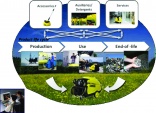Home › magazine › special features › The art of ecodesign
The art of ecodesign
6th of March 2012Ecodesign is the development of environmentally products, ie, minimising a product's environmental impact at the design stage, for its entire life cycle. Eco-efficiency expert Dr Udo Hermenau of e-hoch-3 writes exclusively for ECJ about the challenges presented by true ecodesign, and how it can be incorporated into every company's culture. The company has worked closely with cleaning machine manufacturer Kärcher in Germany in implementing new ideas.
Ecodesign can be defined as the development of environmentally friendly products. It is far more than optimising just one environmental characteristic of a product, eg, raising its recyclability. Ecodesign is minimising a product's environmental burdens right from the design phase, ready for its entire life cycle. Environmental burdens are not just shifted from one life cycle phase to another.
Ecodesign is central to product sustainability. With the public's rising interest in sustainability, companies now realise they have to take care of the environmental burdens of their products, long after they leave the company gate. Raising the company image - a precious good in present times - is a major driver behind environmental product optimisation today. Another important driver is customer sustainability criteria. However, not just end users but rather big retailers are the main drivers - especially in the consumer goods sector. They have already defined their own sustainability criteria for the products they deal with. Ecodesign approaches must also cater to these requirements.
Furthermore, the EU and many national governments and municipalities are pushing the trend towards sustainable products and services in their legislation and tendering procedures. 'Green' public procurement for example is a powerful factor in public tendering in numerous European countries. And even private sector tendering is taking up the trend.
Just a few years ago, for example, no tender documents cared about the environmental burdens of cleaning services - a clean floor for the cheapest price was the dictum. Today many contract cleaners have to prove that their services are environmentally benign, which includes the use of environmentally friendly products. Top companies have foreseen the changes confronting this target group and offer a wider range of corresponding products.
Difficult to implement
But if there is a clear trend to environmentally friendly products, why are such products still so rare? Because 'real' ecodesign is difficult, especially in the beginning.
The challenge of ecodesign is to foresee environmental impacts over the whole life cycle of a product that does not yet exist. Moreover, reducing detrimental impacts directly and indirectly involves technical, economic and market issues. Dealing with these often conflicting concerns requires complex decision making. Nearly every decision in the development process has to deal with the question: what is the better environmental alternative for the whole life cycle? For example: is it better to use more detergent and less water? Or vice versa?
Because reliable information is lacking, time and cost pressure in daily development practice mean that many such decisions are taken as a gut reaction- if they are taken at all. Far too often developers shy away from solving these complex questions and concentrate on technical issues or the optimisation of the one environmental aspect that seems to be relevant in their eyes. In the long run this leads to sub-optimal solutions or - in the worst case - to environmental worsening that affects the whole life cycle.
Many of these problems are home-made. Even nowadays, well intentioned optimisation measures and product development often still start without setting any environmental targets for a product. Ecological optimisation runs out into a 'nice to have' issue to be taken into consideration if it does not collide with other targets, especially cost. Most companies have not yet fully realised that ecodesign implementation needs to be strategically embedded into the development processes to ensure that sustainable framework conditions are established from the outset.
The main and most difficult issue is the definition of a product's environmental targets, always incorporating long- and short-term product and corporate strategy. What role will environmentally friendly products play in future in the company's portfolio? What are the relevant environmental aspects of its product range? How will environmentally sound products influence the corporate image by the customers? What are the company's immediate targets in the next product development process? Relevant questions like these are always on the table when ecodesign is a standard component of product development.
The basis for all downstream decisions is the identification of a product's environmental hotspots. Most cases do not call for complete and detailed life cycle assessments (LCAs) according to ISO 14040-44 . Adequate results are often obtained via more practical 'LCA-screenings', which are a streamlined version of LCA. The outcomes flow into the target definition process. Product related targets are major reference points in product development decision making. They define the weighting of environmental aspects in relation to technical, economic and market related targets. Such information lowers the danger of environmental aspects being pushed behind the other product aspects, which too often leads to no ecological optimisation at all.
Reduction in part numbers
Mainstreaming ecodesign also includes building corporate environmental knowledge, selecting and developing company specific tools such as checklists or easy-to-use LCA tools, and defining responsibilities and necessary changes or supplements in internal workflows. This process of continual improvement will usually not be put in practice unless strategic ecodesign targets are in place.
A good example for the benefits of strategic ecodesign mainstreaming are Kärcher professional cleaning machines. The presence of an 'eco mode' in most products and the reduction of the number of parts to 190 for an industrial scrubber dryer are excellent examples of practical ecodesign. The development of the eco mode solution illustrates the interaction of the different ecodesign implementation aspects - the identification of energy and resource consumption in the use phase as main environmental drivers was the result of an LCA screening.
By strategically pursuing the continuous environmental enhancement of the products, technical and economic solutions were developed to minimise eco burdens while still addressing market acceptance. The eco mode was then inserted as a product feature in the specification document and put into practice in the development process. In the final instance, eco mode protects the environment and helps the user save money - which is an additional selling point on the market.
Ecodesign-oriented workflows facilitate the environmental improvement of products by setting standards at the very early product development stages. This phase is highly significant in terms of the environmental burdens of the later product, because this is where the product specifications are defined and the course is set for the product and its features. Later changes in the development process are expensive - in time and money.
The initial development stages define how much environmentally friendly solutions will cost, ie, how much it is worth to implement them. Ecodesign workflows ensure that in this important period environmental aspects are integrated and defined in the product specification document.
Later on in development workflows do not differ much from conventional ones, except that defined environmental requirements have to be fulfilled in accordance with technical and economic criteria. In this product construction phase, a number of environmentally relevant issues have to be solved. Sometimes what appear to be simple questions may become very complicated when having to consider the effects on the whole life cycle. For example: shall I use cotton or microfibre for a dishcloth? Cotton is a renewable resource, but it needs high inputs of water and pesticides.
Microfibre is made of crude oil, which is a finite resource. And what happens at the end-of-life? Will the product land in household waste and be incinerated for energy recovery? Or will the cotton cloth rot away on the compost or somewhere in the environment, producing methane and nitrous oxide which are harmful to our climate? Will the microfibre cloth get into the environment and increase the gigantic plastic carpet floating in the North Pacific Gyre, where the concentration of plastic in the water is six times the concentration of plankton?
Questions like these make environmental assessment so difficult, because different impacts are often not directly comparable. Environmental knowledge, experience, expert support and the orientation to a company's ecodesign targets help in solving these problems in daily practice. Where possible, the development of specific solutions for different framework conditions, eg, regions, user groups or product functions, may offer the best environmental potential.
The ecodesign development process is complemented by a final LCA screening to validate the optimisation measures. Often it will be sufficient to carry out a partial screening of the changes made, checking the environmental improvement against a product's forerunner.
Is it worth the trouble?
When facing all these challenges that occur when implementing ecodesign in daily development practice the question remains of whether it is worth the trouble. But we believe the real question today is whether it is worth not doing it. Ecodesign is an investment in a company's future. Sustainability has become a market factor, and the demand for sustainable and environmentally friendly products is on the increase. EU and national legislations are pushing this trend, big retailers are taking it into consideration, and more and more end customers are becoming aware of the environmental burdens of the products they use every day.
The benefits of implementing ecodesign clearly overweigh the efforts involved. Ecodesign enhances workflows and communication and generates synergy effects between a company's business units.
Taking time today to consider what requirements tomorrow's products will have to face brings a market advantage and provides a new source for innovation. The image of a company and its products will be upgraded and in the end, we all profit from protecting our environment.
To contact Dr Hermenau directly, email: hermenau@e-3.co or visit: http://e-3.co/











